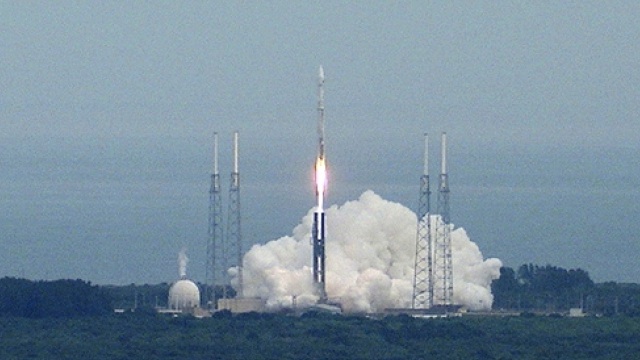SUMMARY
This is AI generated summarization, which may have errors. For context, always refer to the full article.

CAPE CANAVERAL, USA – NASA on Monday, November 18, launched its unmanned MAVEN spacecraft toward Mars to study the Red Planet’s atmosphere for clues as to why Earth’s neighbor lost its warmth and water over time.
The white Atlas V 401 rocket carrying the Mars Atmosphere and Volatile EvolutioN (MAVEN) orbiter blasted off on schedule at 1:28 pm (1828 GMT).
The liftoff of the $671 million spacecraft, followed by a successful separation from the rocket less than an hour later, kicked off the 10-month journey to the Red Planet.
“This day has been picture perfect from beginning to end,” said the mission’s principal investigator, Bruce Jakosky.
NASA flight director Omar Baez described the liftoff and separation as “flawless.”
Arrival at Mars after a 440-million-mile (700 million kilometer) journey is scheduled for September 2014, with the science mission of the solar-wing paneled orbiter set to begin two months later.
The probe is different from past NASA missions because it focuses not on the dry surface but on the mysteries of the never-before-studied upper atmosphere.
Much of MAVEN’s year-long mission will be spent circling the planet 6,000 kilometers (3,800 miles) above the surface.
During that time, it will execute five deep dips to a distance of just 125 kilometers (78 miles) above the Martian landscape to get readings of the atmosphere at various levels.
Researchers have described the mission as a search for a missing piece to the puzzle of what happened to Mars’ atmosphere, perhaps billions of years ago, to transform Earth’s neighbor from a water-bearing planet that might have been favorable for life to a dry, barren desert.
One of its three scientific tools is a solar wind and ionosphere gauge called the Particles and Fields Package, built by the University of California at Berkeley Space Sciences Laboratory.
A second tool, called the Remote Sensing Package, was built by the Laboratory for Atmospheric and Space Physics at the University of Colorado and will determine global characteristics of the upper atmosphere and ionosphere.
The third instrument, the Neutral Gas and Ion Mass Spectrometer, was built by NASA’s Goddard Space Flight Center. It will measure the composition and isotopes of neutrals and ions.
NASA has sent a series of rovers to explore the surface of the Red Planet, including its latest, Curiosity, which arrived last year.
Earlier this month, India launched its own deep space orbiter to find traces of methane from Mars. That spacecraft, the Mars Orbiter Mission, is expected to arrive two days later than MAVEN.
The science goals of the two do not overlap much. The Indian probe will be searching for methane which could prove the existence of some ancient life form, while the US probe seeks answers about the planet’s climate change in the distant past.
In 2016, another orbiter is on track for launch by the European Space Agency and the Russian space agency Roscosmos. The ExoMars Trace Gas Orbiter will measure methane and other atmospheric gases that could signal the presence of life.
Together, the orbiters’ findings, along with the US rovers on the surface, are expected to help pave the way for a future visit by humans to the Red Planet, perhaps as early as 2030, NASA has said. – Rappler.com
Add a comment
How does this make you feel?
There are no comments yet. Add your comment to start the conversation.